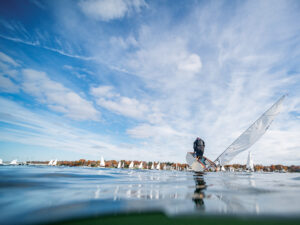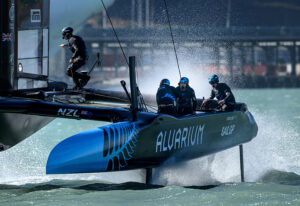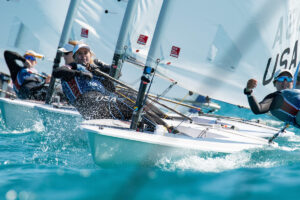On Monday nights a few of us get together to play guitars and sing, sometimes trying out original songs. Whether you write the words first or start with the music seems to depend on the person and the inspiration. Usually there’s the germ of an idea-a musical fragment, a few words, or a concept-that quickly starts changing shape as its influenced by the sound of notes and words together. As we play, other ideas infiltrate the song, both spontaneous and reflective. A similar, though less tuneful process occurs at SW’s office every month as photographers, writers, editors, and designers collaborate to produce an issue. We have our plan for an issue’s stories, such as our 30 Dream Machines, but unexpected events occur as we move toward our deadline. When Olin Stephens sends in an essay, we modify our plan and decide to count such classics as Britannia among our dream machine. On the other hand, Stuart Streuli, senior edior, knew for months that he’d be writing a few thousand words on the Olympic regatta in Athens, but when photographer Richard Langdon caught Kevin Burnham doing a back flip off the wire at the finish line, Streuli had little choice but to lead his story with a description of Burnham’s gyrations. It’s a fun process, tacking on the daily editorial shifts and gusts to make the most of the stories we hear and the photos we see while trying to keep to our orginal issue plan. Creative collaboration is a process that should be instilled in our schools, both because it’s fun and because it’s powerful. Even if you don’t consider yourself creative, think about what happens when you help stage a local regatta. Starting with a plan and working through the details, there’s a place in a regatta’s invention process for every engineer, accountant, and salesperson, as well as painters and poets. Every detail will affect the nature of the event-from choosing the number of races and types of courses to the menu and venue for the parties, the timeliness and display of the scorekeeping to the trophy selection. When you mix in a little wind, weather, and a group of competitive people, and unique occurs that’s as much about a shared experience as it is a competitive plot. In one race somebody port tacks the fleet at the start, or goes from last to first. In the next race, somebody blows out a chute. Onshore, one crew collects champagne won in a bet, another cooks up a pot of lobsters or builds a bonfire on the beach. One way or another, the competitive adrenaline of the day subsides amid a mix of stories, jokes, reflections, and appreciation of being together on the water. A few weeks earlier, when you were tweaking the sailing instructions or deciding where to hold the barbeque, this is what it was all about. A sailing event is a collaboration in time and space that changes depending on what each of us puts into it. Afterwards, it doesn’t sit between the covers like a magazine, but expands as a livign memory for every participant, organizer, and spectator. So does the experience of kids and instructors have in the junior sailing program you helped coordinate, and the team building that occurred while you and your crew got the boat ready for the season. We all have a song to sing, and sailing provides a place to sing it, even if we’re a bit tone deaf. And if you remind the guy on the foredeck to bring his guitar and strum a few bars, the words just might come to you first.









